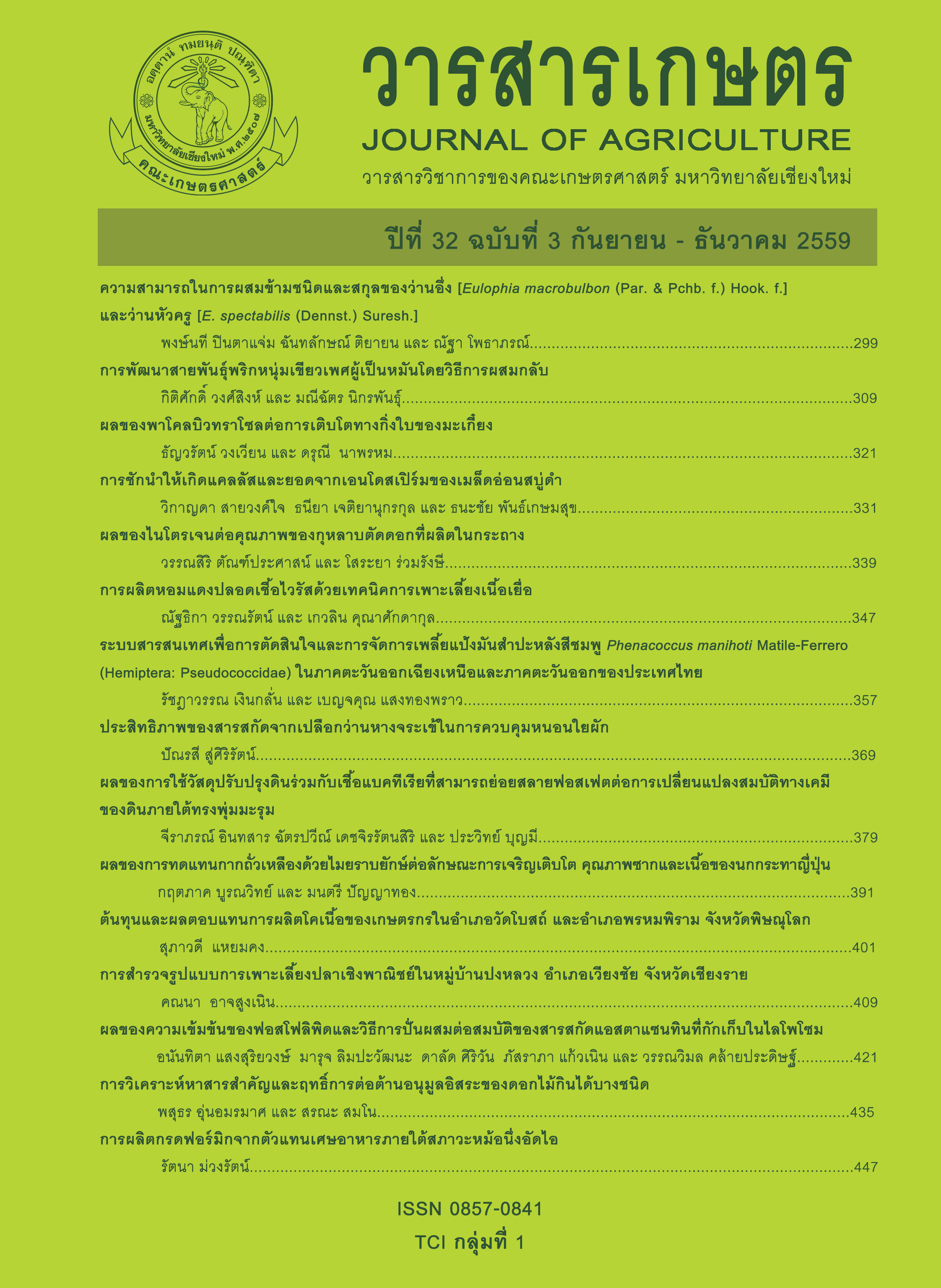การวิเคราะห์หาสารสำคัญและฤทธิ์การต่อต้านอนุมูลอิสระของดอกไม้กินได้บางชนิด
Main Article Content
บทคัดย่อ
งานวิจัยนี้มีจุดประสงค์เพื่อตรวจวิเคราะห์หากลุ่มสารสำคัญ กิจกรรมสารต้านอนุมูลอิสระ และปริมาณสาร ฟีนอลิกทั้งหมดจากสารสกัดของดอกไม้ไทยที่บริโภคได้จำนวน 5 ชนิด ได้แก่ ดอกดาวเรือง (Tagetes erecta L.) ดอกเฟื่องฟ้า (Bougainvillea hybrid) ดอกเข็ม (Lxora chinensis Lamk) ดอกพุดซ้อน (Gardenia jasminoides Ellis) และดอกกุหลาบมอญ (Rosa damascene) ด้วยการสกัดด้วยเฮกเซน ไดคลอโรมีเทน และเมทานอล จากนั้นนำมาจำแนกกลุ่มสารสำคัญด้วยวิธีโครมาโตกราฟฟีแผ่นบาง (TLC) และทำการวิเคราะห์หาฤทธิ์ต้านอนุมูลอิสระด้วยวิธี 2,2-diphenyl-1-picryhydrazyl (DPPH) radical scavenging assay, Trolox-Equivalent Antioxidant Capacity (TEAC) และปริมาณสารฟีนอลิกทั้งหมด จากผลการทดลองพบว่าการสกัดด้วยเมทานอลให้ปริมาณผลผลิตของสารที่สกัดได้สูงที่สุดร้อยละ 8-12 และการจำแนกสารสำคัญด้วยวิธีโครมาโตกราฟฟีแผ่นบาง (TLC) พบสารสำคัญในกลุ่ม ฟลาโวนอยด์และสารประกอบฟีนอลิกในสารสกัดของดอกไม้ทุกชนิดที่สกัดด้วยเมทานอล สารสกัดเมทานอลจากดอกกุหลาบมอญ ดอกเข็มและดอกดาวเรืองมีความสามารถในการต้านอนุมูลอิสระ DPPH สูงถึงร้อยละ 90 และสารสกัดเมทานอลจากดอกไม้ทั้ง 5 ชนิดมีฤทธิ์การต้านอนุมูลอิสระด้วยวิธี TEAC สูงถึงร้อยละ 90 มากกว่าสารกัดเฮกเซน และ ไดคลอโรมีเทนอย่างมีนัยสำคัญทางสถิติ (p<0.05) และมีความสามารถในการต้านอนุมูลอิสระเทียบเท่ากับสาร trolox ประมาณ 17 มิลลิกรัมต่อตัวอย่าง 1 กรัม ส่วนสารสกัดเมทานอลจากดอกกุหลาบมอญมีปริมาณสารฟีนอลิกทั้งหมดสูงที่สุด (31.91 mg gallic acid equivalents/ g sample) ซึ่งแตกต่างอย่างมีนัยสำคัญทางสถิติกับดอกไม้ที่นำมาทดสอบชนิดอื่น ๆ (p<0.05)
Article Details
References
รัตนา อินทรานุปกรณ์. 2550 (พิมพ์ครั้งที่ 2). การตรวจสอบและการสกัดแยกสารสำคัญจากสมุนไพร. แอคทีฟ พรินท์, กรุงเทพฯ. 215 หน้า.
พัชรี สิริตระกูลศักดิ์ ประสิทธิ์ ชุติชูเดช เบ็ญจวรรณ ชุติชูเดช มาระตรี เปลี่ยนศิริชัย และ เกรียงศักดิ์ บุญเที่ยง. 2556. กิจกรรมสารต้านอนุมูลอิสระของดอกไม้กินได้ 15 ชนิด ในจังหวัดมหาสารคาม. วารสารแก่นเกษตร พิเศษ(1): 607-611
ลดาชาติ แต่พงษ์โสรัถ อธิกา จารุโชติกมล วนิดา ไทรชมภู และ ปิยะวรรณ กำลังมาก. 2544. รายงานการวิจัยฤทธิ์ต้าน ออกซิแดนท์ของผักพื้นบ้านในเขตจังหวัดมหาสารคาม. รายงานการวิจัย. ภาควิชาชีววิทยา คณะวิทยาศาสตร์ มหาวิทยาลัยมหาสารคาม, มหาสารคาม. 36 หน้า.
วาทิน พูลสวัสดิ์ และ จีรวัฒน์ สวัสด์พิพัฒน์. 2556. ฤทธิ์การต้านออกซิเดชั่นและพฤกษเคมีของดอกไม้กินได้. (ระบบออนไลน์). แหล่งข้อมูล: http://www.pharmacy.mahidol.ac.th/newspdf/specialproject/2556-25.pdf (20 พฤษภาคม 2559).
แววจันทร์ พงค์จันตา พัชราพร ไชยชนะ และ พิทยา สรวมศิริ. 2549. ประสิทธิภาพของสารสกัดหยาบจากตะไคร้หอมในการควบคุมเชื้อราสาเหตุโรคผลเน่าในมะม่วงและโรคโคนเน่าในผัก. วารสารเกษตร 22(1): 75-80
สุพัตรา แซ่ลิ่ม. 2548. อาหารจานดอกไม้. สำนักพิมพ์คุณพ่อ, กรุงเทพฯ. 176 หน้า.
สุรินทร์ นิลสำราญจิต และสริยา ตาเที่ยง. 2558. สัณฐานวิทยาเมล็ดและสารประกอบโพลีฟีนอลของลำไย. วารสารเกษตร 31(2): 167-175
อรสุรินทร์ ฮวบบางยาง มัณฑนา บัวหนอง เฉลิมชัย วงษ์อารี ชัยรัตน์ เตชวุฒิพร และวาริช ศรีละออง. 2553. การศึกษาคุณค่าทางอาหารและความสามารถในการต้านอนุมูลอิสระในดอกไม้ที่รับประทานได้ วารสารวิทยาศาสตร์ เกษตรศาสตร์ 41(3/1)(พิเศษ): 381-384
Boonyaprapatsara, N. 2000. Thai traditional herbal medicine plant Vols. 1 and 4. Prachachon Publishers, Bangkok.
Bushra, S., A. Farooq and A. Muhammad. 2009. Effect of extraction solvent technique on the antioxidant activity of selected medicinal plant extracts. Molecules. 14: 2167-2180.
Chaichit, C. 2004. Thai herbs and herbal products. The National Identity Office. Bangkok. 240 p.
Chuakul, W., P. Saralamp, W. Paonil, R. Temsiri-rikkul and T. Clayton. 1997. Medicinal plants in Thailand Volume II. Amarin Printing and Publishing Public. Bangkok. 248 p.
Duan, X., T. Liu, D. Zhang, X. Su, H. Lin and Y. Jiang. 2011. Effect of pure oxygen atmosphere on antioxidant enzyme and antioxidant activity of harvested litchi fruit during storage. Food Research International 44: 1905-1911.
Kaisoon, O., S. Siriamornpun, N. Weerapreeyakul and N., Meeso. 2011. Phenolic compounds and antioxidant activities of edible flowers from Thailand. Food Research International 3: 88-99.
Kaisoon, O., I. Konczak and S. Siriamornpun. 2012. Potential health enhancing properties of edible flowers from Thailand. Food Research International 46(2): 563-5.
Kaur, G., M.S. Alamb, Z. Jabbar, K. Javed and M. Athar. 2006. Evaluation of antioxidant activity of Cassia siamea flowers. Jounal Ethnopharmacology 108: 340-348.
Krasaekoopt, W. and A. Kongkarnchanatip. 2005. Anti-microbial properties of Thai traditional flower vegetable extracts. Assumption University Journal of Technology 9(2): 71-74.
Lagu, C. and K.I.B. Frederick. 2012. In vitro antimicrobial activity of crude extracts of Erythrina abyssinica and Capsicum annum in poultry diseases control in the South Western agro-ecological zone of Uganda. pp. 597-614. In: Perez-Marin, C.C. (Ed.). A Bird's-Eye View of Veterinary Medicine. InTech. Rijeka.
Malbasa, R., E. Loncar and L. Kolarov. 2004. TLC analysis of some phenolic compounds in Kombucha beverage, Acta Periodica Technologica 35: 199-205.
Molan, A.L., J. Flanagan, W. Wei and P.J. Moughan. 2009. Selenium-containing green tea has higher antioxidant and prebiotic activities than regular green tea. Food Chemistry 114: 829-835.
Peschel, W., F. Sanchez-Rabaneda, W. Dn, A. Plescher, I. Gartzia, D. Jimenez ,R. Lamuela-Raventos, S. Buxaderas and C. Condina. 2006. An industrial approach in the search of natural antioxidants from vegetable and fruit wastes. Food Chemistry 97: 137-150.
Plailek, W. 2005. Edible flowers. Home and Garden Press (In Thai). Bangkok.
Saralamp, P., W. Chuakul, R. Temsiririrkkul and T. Claylon. 1996. Medicinal plants in Thailand. Volume I. Amarin Printing and Publishing Public. Bangkok. 219 p.
Shi, J., J. Gong, J. Liu, X. Wu and Y. Zhang. 2008. Antioxidant capacity of extract from edible flowers of Prunsmume in China and its active components. Food Science Technology 42: 477-482.
Sommano, S., N. Caffin and G. Kerven. 2013. Screening for Antioxidant Activity, Phenolic Content, and Flavonoids from Australian Native Food Plants. International Journal of Food Properties 16(6): 1394-1406.
Stahl, E. 1969. Thin Layer Chromatography. 2nd ed. Springer-Verlag. New York. 1041 p.
Sultana, B., F. Anwar and M. Ashraf. 2009. Effect of extraction solvent/technique on the antioxidant activity of selected medicinal plant extracts. Molecules 14: 2167-2180.
Touchstone, J.C. 2015. Practice of Thin Layer Chromatography. 3rd ed. Wiley-Interscience. New York. 400 p.
Youwei, Z., Z. Jinlian and P. Yonghong. 2008. A comparative study on the free radical scavenging activities of some fresh flowers in southern China. LWT-Food Science and Technology 41: 1586-1591.
Vachirasup, T. 1995. Senna plant in Thailand, 1st ed. Mahidol University, Faculty of Pharmacy, Bangkok

